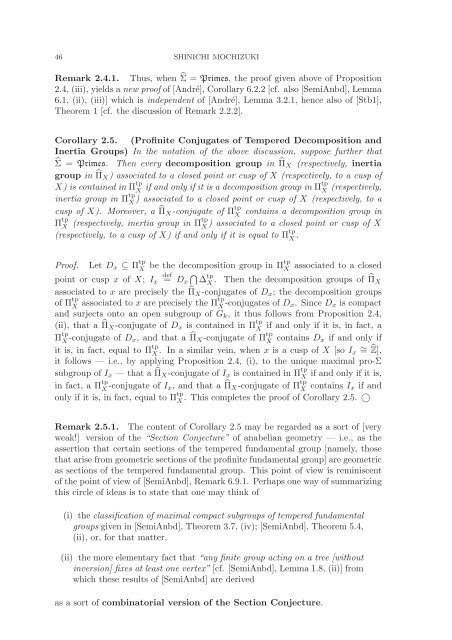Inter-universal Teichmuller Theory I: Construction of Hodge Theaters
Inter-universal Teichmuller Theory I: Construction of Hodge Theaters
Inter-universal Teichmuller Theory I: Construction of Hodge Theaters
Create successful ePaper yourself
Turn your PDF publications into a flip-book with our unique Google optimized e-Paper software.
46 SHINICHI MOCHIZUKI<br />
Remark 2.4.1. Thus, when ̂Σ =Primes, the pro<strong>of</strong> given above <strong>of</strong> Proposition<br />
2.4, (iii), yields a new pro<strong>of</strong> <strong>of</strong> [André], Corollary 6.2.2 [cf. also [SemiAnbd], Lemma<br />
6.1, (ii), (iii)] which is independent <strong>of</strong> [André], Lemma 3.2.1, hence also <strong>of</strong> [Stb1],<br />
Theorem 1 [cf. the discussion <strong>of</strong> Remark 2.2.2].<br />
Corollary 2.5. (Pr<strong>of</strong>inite Conjugates <strong>of</strong> Tempered Decomposition and<br />
Inertia Groups) In the notation <strong>of</strong> the above discussion, suppose further that<br />
̂Σ =Primes. Then every decomposition group in ̂Π X (respectively, inertia<br />
group in ̂Π X ) associated to a closed point or cusp <strong>of</strong> X (respectively, to a cusp <strong>of</strong><br />
X) is contained in Π tp X if and only if it is a decomposition group in Πtp X (respectively,<br />
inertia group in Π tp X<br />
) associated to a closed point or cusp <strong>of</strong> X (respectively, to a<br />
cusp <strong>of</strong> X). Moreover, a ̂Π X -conjugate <strong>of</strong> Π tp X<br />
contains a decomposition group in<br />
Π tp X<br />
(respectively, inertia group in Πtp X<br />
) associated to a closed point or cusp <strong>of</strong> X<br />
(respectively, to a cusp <strong>of</strong> X) if and only if it is equal to Π tp X .<br />
Pro<strong>of</strong>. Let D x ⊆ Π tp X be the decomposition group in Πtp X<br />
associated to a closed<br />
def ⋂<br />
point or cusp x <strong>of</strong> X; I x = D x Δ<br />
tp<br />
X . Then the decomposition groups <strong>of</strong> ̂Π X<br />
associated to x are precisely the ̂Π X -conjugates <strong>of</strong> D x ; the decomposition groups<br />
<strong>of</strong> Π tp X associated to x are precisely the Πtp X -conjugates <strong>of</strong> D x.SinceD x is compact<br />
and surjects onto an open subgroup <strong>of</strong> G k , it thus follows from Proposition 2.4,<br />
(ii), that a ̂Π X -conjugate <strong>of</strong> D x is contained in Π tp X<br />
ifandonlyifitis,infact,a<br />
Π tp X -conjugate <strong>of</strong> D x, and that a ̂Π X -conjugate <strong>of</strong> Π tp X<br />
contains D x if and only if<br />
it is, in fact, equal to Π tp X . In a similar vein, when x is a cusp <strong>of</strong> X [so I ∼ x = Ẑ],<br />
it follows — i.e., by applying Proposition 2.4, (i), to the unique maximal pro-Σ<br />
subgroup <strong>of</strong> I x —thatâΠ X -conjugate <strong>of</strong> I x is contained in Π tp X ifandonlyifitis,<br />
in fact, a Π tp X -conjugate <strong>of</strong> I x, and that a ̂Π X -conjugate <strong>of</strong> Π tp X contains I x if and<br />
only if it is, in fact, equal to Π tp X<br />
. This completes the pro<strong>of</strong> <strong>of</strong> Corollary 2.5. ○<br />
Remark 2.5.1. The content <strong>of</strong> Corollary 2.5 may be regarded as a sort <strong>of</strong> [very<br />
weak!] version <strong>of</strong> the “Section Conjecture” <strong>of</strong> anabelian geometry — i.e., as the<br />
assertion that certain sections <strong>of</strong> the tempered fundamental group [namely, those<br />
that arise from geometric sections <strong>of</strong> the pr<strong>of</strong>inite fundamental group] are geometric<br />
as sections <strong>of</strong> the tempered fundamental group. This point <strong>of</strong> view is reminiscent<br />
<strong>of</strong> the point <strong>of</strong> view <strong>of</strong> [SemiAnbd], Remark 6.9.1. Perhaps one way <strong>of</strong> summarizing<br />
this circle <strong>of</strong> ideas is to state that one may think <strong>of</strong><br />
(i) the classification <strong>of</strong> maximal compact subgroups <strong>of</strong> tempered fundamental<br />
groups given in [SemiAnbd], Theorem 3.7, (iv); [SemiAnbd], Theorem 5.4,<br />
(ii), or, for that matter,<br />
(ii) the more elementary fact that “any finite group acting on a tree [without<br />
inversion] fixes at least one vertex” [cf. [SemiAnbd], Lemma 1.8, (ii)] from<br />
which these results <strong>of</strong> [SemiAnbd] are derived<br />
as a sort <strong>of</strong> combinatorial version <strong>of</strong> the Section Conjecture.
















